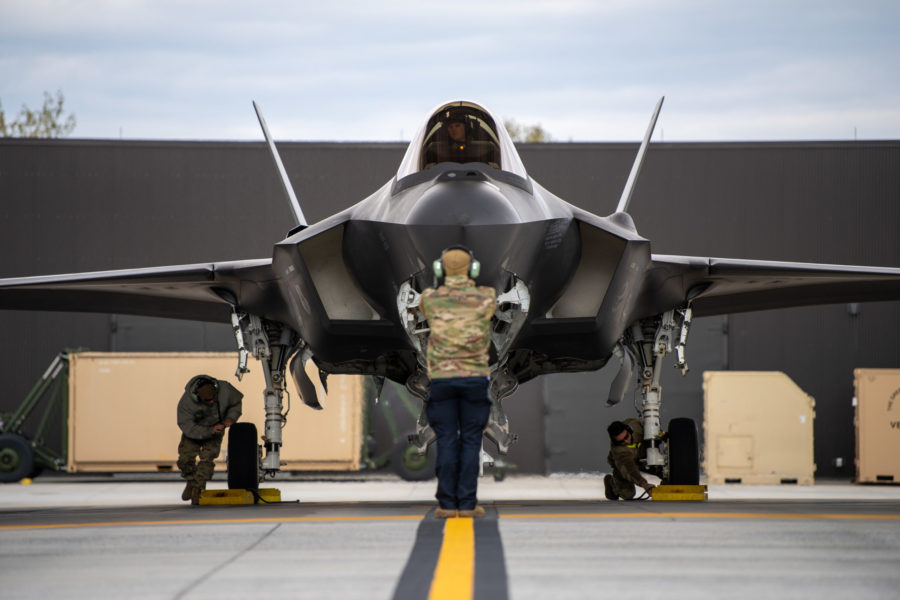The Pentagon will soon decide whether to move ahead with a new engine for the F-35, and officials won’t simply table the issue indefinitely, Defense Department acquisition and sustainment chief William LaPlante said at an acquisition conference. He also said calls to break up the F-35 Joint Program Office and distribute its development functions to the services are premature but that he supports the services taking over sustainment of their own F-35 fleets.
“It’s predecisional. We’re in the middle of lots of meetings” on the Adaptive Engine Transition Program, or AETP, LaPlante said at an Oct. 25 acquisition conference sponsored by the Potomac Officers Club. But, he pledged, “We are not going to kick the can. We are going to make a decision,” he said, suggesting that the choice will appear in the fiscal 2024 budget request. “And that’s what’s going on right now.”
The Pentagon has been debating for more than a year whether some or all of the F-35 fleet should be refitted with new engines, after some members of Congress urged the Pentagon to pursue such a program. General Electric has prototyped the XA-100 and Pratt & Whitney the XA-101, both of which can fit the F-35A, but which are less easy to fit to the F-35B and C models.
The Joint Program Office has said that if the Air Force wants an AETP engine in its F-35As, it will have to pay for the development and integration itself, because the rules of the international F-35 partnership are, “you have to pay to be different,” former JPO director retired Lt. Gen. Eric Fick said in 2021.
Air Force Secretary Frank Kendall said at the fiscal 2023 budget rollout that he’s been talking to the Navy about going in on the AETP together but has not commented recently on the progress of those discussions.
GE Aviation has been pressing for the AETP to be fitted to the F-35 fleet in the Block 4 version of the F-35, saying it can have the engine ready by 2027. GE has been locked out of the F-35 engine market since Congress voted to terminate GE’s alternate F136 engine for the fighter in 2011. Pratt & Whitney—part of Raytheon Technologies—has said it can also provide its AETP engine, but has been pushing for an upgrade of the existing F135 powerplant, which it alone makes. The AETP was originally envisioned as not only exploring more powerful and efficient engines, but potentially setting up an annual engine procurement competition between the two companies.
Some members of Congress have also come out against refitting the F-35 with an AETP powerplant, saying it would be cost-prohibitive for the Air Force to do it alone and that it would undercut the commonality of aircraft among the various users that the program has painstakingly preserved.
LaPlante said the AETP initiative has “in my view … done everything it was advertised to do, in terms of getting efficiencies both in power and potential for range and fuel savings.” The only thing standing in the way of a production program, he said, is “just money.”
It’s a matter of “whether we take it and go to the next phase—which is going to some of degree of serious engineering and manufacturing development—and then cut that in” to the production line, “or do another option.” The F135 update is the other option.
However, “Doing nothing on the F-35 engine is not an option … We have to do life extension” on the engine, and “We have to do something about its ability to generate power. And, we may have to do something—or want to do something—on performance. Which gets you to AETP,” he said.
“All of those factors are under consideration right now,” LaPlante added.
He dismissed the idea of disbanding the F-35 JPO in the near future as “pretty stupid.”
The F-35, he said, is “still in development” with the Block 4 version. “You don’t break up a program office that’s doing development … We need the JPO to finish development,” something he predicted would happen in about five years. “Then,” he said, “we can revisit it.”
The Pentagon is, though, trying to “get the sustainment back to the services … to make sure the services own the sustainment … So that’s where I see that moving.”
An important consideration, he added, is the F-35 international partners, eight of which are “plank holders” who have been part of the program since its inception.
“This is not FMS,” he said, referring to Foreign Military Sales. The international partners are “part of the governance” of the F-35, and “They love the JPO.”
They view the JPO as “an honest broker … trying to balance the equities between the partners, and maybe even our services in this country,” and they would likely object to the JPO’s being undercut. This fact “doesn’t get much attention in Washington.”
“The fact of the matter is, the JPO does incredible work” keeping the partners informed and involved on the program’s progress, LaPlante said.
“The partners trust the JPO, and it’s one of the most successful programs, I think, ever in the history of DOD.” For now, he said, “in the sense of moving to the next phase,” it will only be about moving the sustainment of the F-35 “back to the services.”
